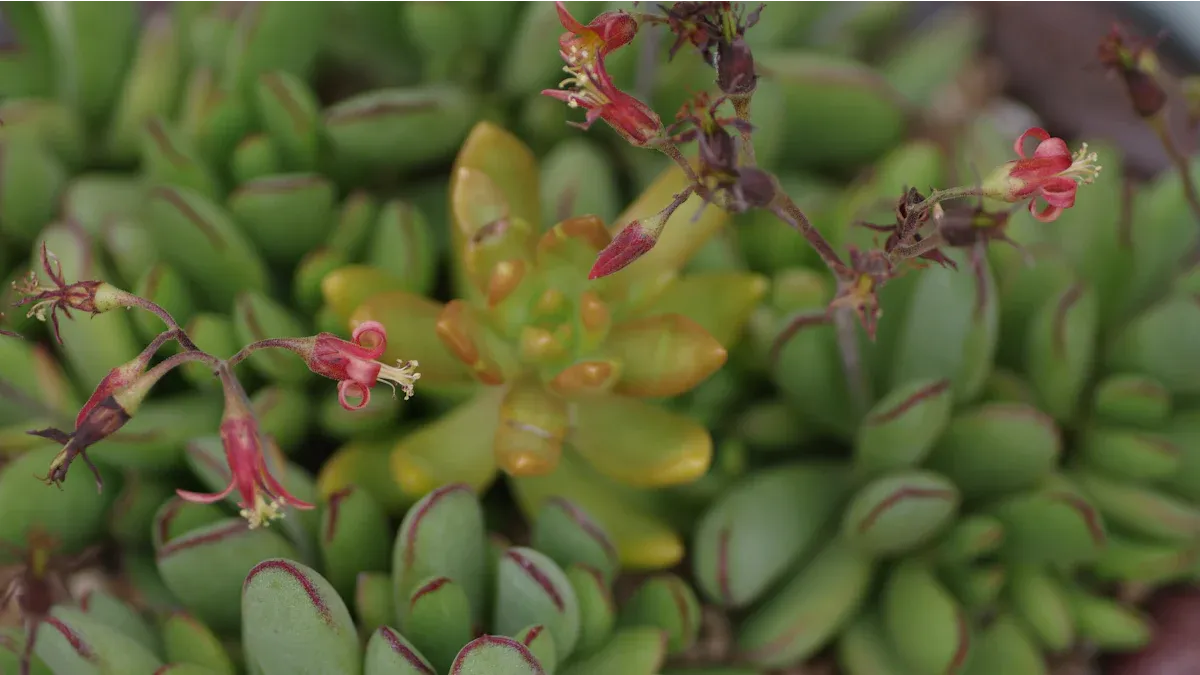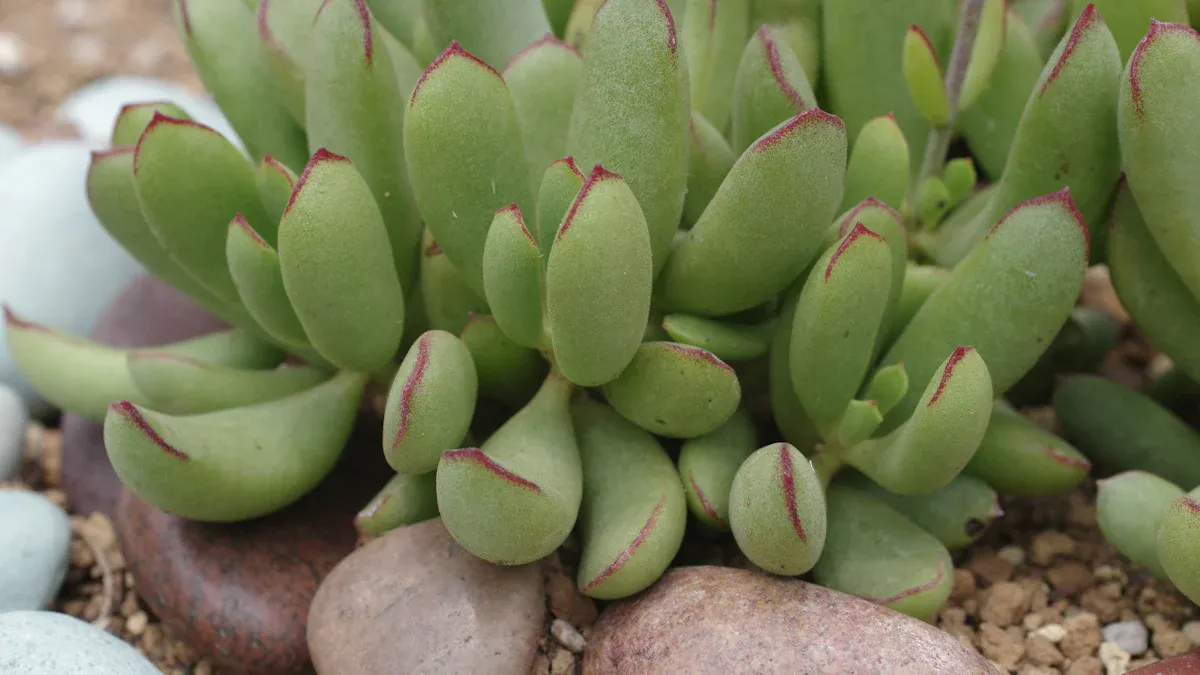
You may ask if cotyledon pendens like full sun. These plants do well in bright light. Too much direct sun can burn them. Light helps cotyledons grow and get stronger. Here is how light affects cotyledons:
| Light Condition | Duration | Effect on Cotyledons |
|---|---|---|
| Short-Day (SD) | 12 h light/12 h dark | Growth and gene changes happen |
| Long-Day (LD) | 16 h light/8 h dark | Photosynthesis and growth get better |
Key Takeaways
- Cotyledon pendens grow best in bright light. They need at least 6 hours of direct sunlight each day to grow well. Watch your plant for stress, like burned leaves or dry leaves. Change how much sun or water it gets if you see these signs. Use soil that drains water well and a pot with holes at the bottom. This helps stop root rot, especially when it is sunny.
Sunlight Needs

Full Sun vs. Partial Shade
Cotyledon pendens loves sunlight, but you need to find the right balance. If you give your plant full sun exposure, it will grow strong and healthy. Horticultural experts say you should aim for at least 6 hours of direct sunlight each day. This amount helps your plant thrive and encourages blooming. Some gardeners notice that bright direct light makes the leaves plump and colorful. Too much sunlight, though, can cause leaf burn. You might want to try partial shade during the hottest part of the day, especially if you see signs of stress.
Tip: If you grow Cotyledon pendens outdoors, watch how the sunlight moves across your garden. Place your plant where it gets morning sun and afternoon shade. This way, you protect it from harsh midday rays.
Indoor Light Placement
Growing Cotyledon pendens indoors means you need to maximize exposure to light. Put your plant on a sunny windowsill. Make sure it gets at least 10 hours of indirect sunlight every day. Rotate the pot every week so all sides get bright direct light. If your home does not have enough natural sunlight, you can use artificial lights. T5 HO fluorescent tubes and LED lights work well for succulents. These lights give strong, safe exposure and help your plant stay healthy. Avoid HID lamps because they get too hot and may damage your Cotyledon pendens.
- Place your plant near a south-facing window for best results.
- Use LED grow lights if your room is dark.
- Rotate your pot for even exposure.
Cotyledon pendens care in full sun
Watering Tips
When you place pendens in full sun, you need to pay close attention to how much water it gets. Sunlight helps cotyledon pendens grow and brings out bright colors in the leaves. If you give your plant more sun, it will need more water. The soil dries out faster, and the plant uses water quickly.
- Check the soil with your finger. If the top inch feels dry, it is time to water.
- Water deeply, but let the soil dry out before you water again.
- Avoid letting the plant sit in water. Too much water can cause root rot.
- In summer, you may need to water more often. In winter, cut back on watering.
Pendens is a drought-tolerant plant, but it still needs regular checks. If you see the leaves shriveling, your plant may need more water. If the leaves turn mushy, you may be watering too much. Finding the right balance is part of good cotyledon pendens care.
💧 Tip: Increased sunlight means increased watering requirements. Always adjust your routine if you move your pendens to a sunnier spot.
Soil and Pot Selection
The right soil helps pendens thrive in full sun. You want a mix that drains water fast and keeps roots healthy. Cotyledon pendens likes a very porous, sandy mix. This type of soil lets water flow through and keeps roots from staying wet.
- Mix 60% sand or perlite with 40% potting soil for best results.
- You can also use a cactus potting mix. It works well for pendens and other succulents.
- Choose a pot with drainage holes. This helps extra water escape and protects the roots.
A well-drained potting mix is key for pendens in sunny spots. Good drainage keeps your cotyledon healthy and prevents root rot. If you use a heavy or clay soil, your plant may struggle. Always check the soil after watering to make sure it dries out between waterings.
Acclimation Steps
Moving pendens into full sun takes a little planning. You do not want to shock the plant. Start by giving it a few hours of morning sun each day. Increase the time in the sun slowly over one or two weeks. This helps the leaves get used to the bright light.
- Place your cotyledon in a spot with gentle morning sun at first.
- Add an extra hour of sun every few days.
- Watch for signs of sunburn, like brown or white patches on the leaves.
- Rotate the pot every week. This gives all sides of the plant even exposure.
If you see any signs of stress, move your pendens back to a shadier spot for a few days. Acclimation is one of the most important care requirements for healthy cotyledon pendens. With patience, your plant will adjust and thrive in its new sunny home.
🌞 Note: Always monitor your pendens for sunburn during this process. Rotating the pot helps prevent one side from getting too much sun.
Sun Stress Signs
Leaf Burn
You might notice your cotyledon looking a little crispy after a hot day. Leaf burn happens when your plant gets too much direct sunlight. The leaves can show brown or white patches, and sometimes they even feel dry to the touch. If you see these signs, your plant is telling you it needs a break from the sun.
Here are some things that increase the risk of leaf burn:
- Direct full sunlight for long periods
- Sudden changes in light exposure
- Hot afternoon rays
If you spot leaf burn, move your cotyledon to a spot with gentle morning sun or partial shade. You can also rotate the pot to help all sides get even light. Keeping an eye on your plant helps you catch problems early.
🌱 Tip: Leaf burn is common during summer or heat waves. Shade cloth or a sheer curtain can protect your plant.
Dehydration
Dehydration is another stress sign you should watch for. Cotyledon pendens can handle drought, but it still needs water to stay healthy. When your plant gets too dry, the leaves start to wrinkle or pucker. Sometimes, the bottom leaves look shriveled. This means your plant is thirsty.
Look for these symptoms:
- Wrinkled or puckered leaves
- Shriveling at the bottom
- Soil feels completely dry
To fix dehydration:
- Water every 10-14 days in spring and summer
- Cut back to every 3-4 weeks in fall and winter
- Make sure water drains from the bottom of the pot
- Use a gritty, well-draining soil mix
- Place your plant in a well-ventilated area after watering
If you see soft, translucent leaves, you might be watering too much. Always check the soil before you water. Your cotyledon will thank you for the extra care!
Transitioning Outdoors
Gradual Exposure
Moving your Cotyledon pendens outside can help it grow stronger, but you need to do it slowly. Spring is the best time to start this process. The sun feels gentle, and your plant can adjust without too much stress. If you move your plant outside in summer or autumn, pick days when the sun is not too harsh.
Here’s how you can help your plant adjust:
- Start by placing your Cotyledon pendens in a spot with bright, indirect sunlight.
- Avoid direct sunlight all day, especially if you live in a place with strong sun.
- Give your plant a few hours of morning sun, then move it to a shaded area for the rest of the day.
- Use a sunshade or place your plant under a tree if the afternoon sun feels too hot.
- Add more sunlight each day over one or two weeks.
- Watch for signs of sunburn, like brown or white spots on the leaves.
🌤️ Tip: Spring is also a good time to repot your Cotyledon pendens. This helps the roots grow and makes the transition easier.
Monitoring Health
You want your Cotyledon pendens to stay healthy as it gets used to outdoor life. Keep an eye on the leaves and soil. Healthy leaves look plump and green. If you see wrinkled leaves, your plant might need more water. If the leaves feel soft or start to fall off, you may be watering too much.
- Water every 10-14 days during the growing season.
- Cut back to every 3-4 weeks when your plant is resting.
- Use a gritty soil mix so water drains out easily.
- Make sure the pot has drainage holes.
Check your plant every few days. If you notice any problems, move it back to a shadier spot or adjust your watering. With a little care, your Cotyledon pendens will love its new outdoor home!
You want your cotyledon pendens to thrive, so give it bright light but avoid harsh sun all day. Watch for sunburn and adjust your care as needed. Try these tips:
- Give plenty of sunlight, but not all-day direct sun.
- Use a sunshade in summer.
- Check for sun spots on your cotyledon.
FAQ
Can Cotyledon pendens survive in low light?
You can keep Cotyledon pendens in low light, but growth slows down. Leaves may look pale. Try to give your plant bright light for best results.
How do I know if my Cotyledon pendens gets too much sun?
Look for brown or white spots on the leaves. If you see these, move your plant to a spot with less direct sunlight.
Should I fertilize Cotyledon pendens in full sun?
You can use a cactus fertilizer once a month during spring and summer. Avoid fertilizing in winter. Too much fertilizer can harm your plant.
🌱 Tip: Always water after you fertilize to protect the roots.